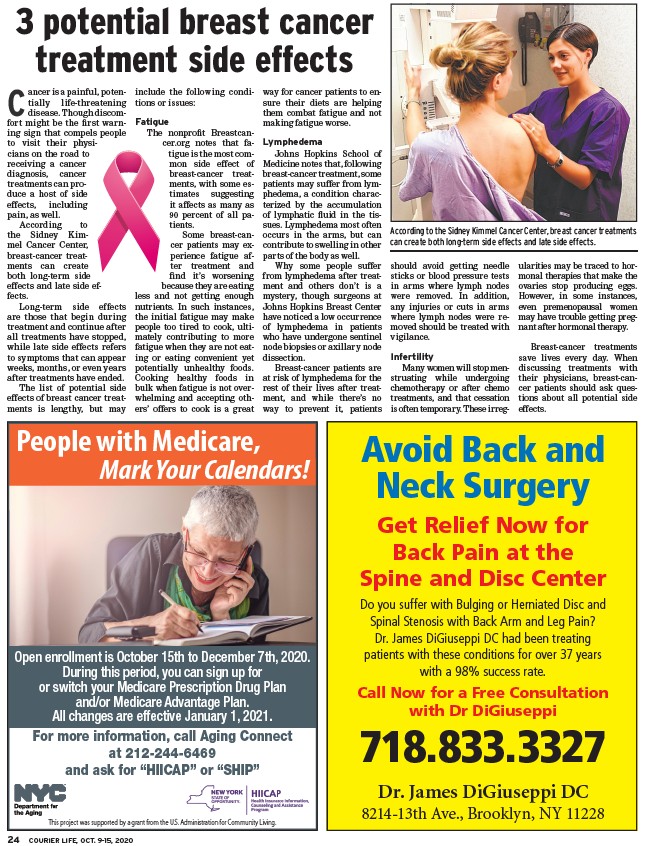
Cancer is a painful, potentially
life-threatening
disease. Though discomfort
might be the fi rst warning
sign that compels people
to visit their physicians
on the road to
receiving a cancer
diagnosis, cancer
treatments can produce
a host of side
effects, including
pain, as well.
According to
the Sidney Kimmel
Cancer Center,
breast-cancer treatments
can create
both long-term side
effects and late side effects.
Long-term side effects
are those that begin during
treatment and continue after
all treatments have stopped,
while late side effects refers
to symptoms that can appear
weeks, months, or even years
after treatments have ended.
The list of potential side
effects of breast cancer treatments
is lengthy, but may
COURIER L 24 IFE, OCT. 9-15, 2020
include the following conditions
or issues:
Fatigue
The nonprofi t Breastcancer.
org notes that fatigue
is the most common
side effect of
breast-cancer treatments,
with some estimates
suggesting
it affects as many as
90 percent of all patients.
Some breast-cancer
patients may experience
fatigue after
treatment and
fi nd it’s worsening
because they are eating
less and not getting enough
nutrients. In such instances,
the initial fatigue may make
people too tired to cook, ultimately
contributing to more
fatigue when they are not eating
or eating convenient yet
potentially unhealthy foods.
Cooking healthy foods in
bulk when fatigue is not overwhelming
and accepting others’
offers to cook is a great
way for cancer patients to ensure
their diets are helping
them combat fatigue and not
making fatigue worse.
Lymphedema
Johns Hopkins School of
Medicine notes that, following
breast-cancer treatment, some
patients may suffer from lymphedema,
a condition characterized
by the accumulation
of lymphatic fl uid in the tissues.
Lymphedema most often
occurs in the arms, but can
contribute to swelling in other
parts of the body as well.
Why some people suffer
from lymphedema after treatment
and others don’t is a
mystery, though surgeons at
Johns Hopkins Breast Center
have noticed a low occurrence
of lymphedema in patients
who have undergone sentinel
node biopsies or axillary node
dissection.
Breast-cancer patients are
at risk of lymphedema for the
rest of their lives after treatment,
and while there’s no
way to prevent it, patients
According to the Sidney Kimmel Cancer Center, breast cancer treatments
can create both long-term side effects and late side effects.
should avoid getting needle
sticks or blood pressure tests
in arms where lymph nodes
were removed. In addition,
any injuries or cuts in arms
where lymph nodes were removed
should be treated with
vigilance.
Infertility
Many women will stop menstruating
while undergoing
chemotherapy or after chemo
treatments, and that cessation
is often temporary. These irregularities
may be traced to hormonal
therapies that make the
ovaries stop producing eggs.
However, in some instances,
even premenopausal women
may have trouble getting pregnant
after hormonal therapy.
Breast-cancer treatments
save lives every day. When
discussing treatments with
their physicians, breast-cancer
patients should ask questions
about all potential side
effects.
3 potential breast cancer
treatment side effects
People with Medicare,
Mark Your Calendars!
Open enrollment is October 15th to December 7th, 2020.
During this period, you can sign up for
or switch your Medicare Prescription Drug Plan
and/or Medicare Advantage Plan.
All changes are effective January 1, 2021.
For more information, call Aging Connect
at 212-244-6469
and ask for “HIICAP” or “SHIP”
This project was supported by a grant from the U.S. Administration for Community Living.
Avoid Back and
Neck Surgery
Get Relief Now for
Back Pain at the
Spine and Disc Center
Do you suffer with Bulging or Herniated Disc and
Spinal Stenosis with Back Arm and Leg Pain?
Dr. James DiGiuseppi DC had been treating
patients with these conditions for over 37 years
with a 98% success rate.
Call Now for a Free Consultation
with Dr DiGiuseppi
718.833.3327
Dr. James DiGiuseppi DC
8214-13th Ave., Brooklyn, NY 11228